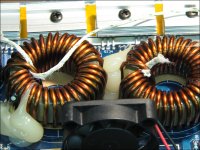I got another one of theese amps in..
All the power supply fets were shorted in the amp,
I replaced the power supply fets and checked all the drivers they all tested fine, I also checked all gate resistors..
When trying to power the amp up it draws excessive current ..
I removed the output driverboard to disable the outputs Amp still draws 60+ amps of current..
With power and ground only i get nothing as soon as i apply remote voltage thats when the amp draws current even with the audio driverboard removed..
Any ideas?
All the power supply fets were shorted in the amp,
I replaced the power supply fets and checked all the drivers they all tested fine, I also checked all gate resistors..
When trying to power the amp up it draws excessive current ..
I removed the output driverboard to disable the outputs Amp still draws 60+ amps of current..
With power and ground only i get nothing as soon as i apply remote voltage thats when the amp draws current even with the audio driverboard removed..
Any ideas?
You should be working through a current limiter.
Twist the transformer to see if the excessive current draw changes.
If there is no change, remove the rectifiers and see if that changes anything.
Twist the transformer to see if the excessive current draw changes.
If there is no change, remove the rectifiers and see if that changes anything.
If the output FETs don't appear shorted, it's possible that they have broken legs. That could cause excessive current draw.
Removed all outputs from the amp along with the audio driverboard..
Checked the rectifiers all test good i re-installed the rectifiers..
Current draw is back..
Should i remove 1 rail cap at a time to see if the current draw goes away?
Im thinking maybe i have a shorted cap..
Checked the rectifiers all test good i re-installed the rectifiers..
Current draw is back..
Should i remove 1 rail cap at a time to see if the current draw goes away?
Im thinking maybe i have a shorted cap..
Removed the rail caps ..
So now with all the rail caps outputs and output driverboard removed and the rectifiers ack in the amp it still draws excessive current..
With the rectifiers out the amp powers up and idles fine..
Should i remove 1 output filter inductor at a time to see if 1 is shorted or any suggestions on what i should check next?
So now with all the rail caps outputs and output driverboard removed and the rectifiers ack in the amp it still draws excessive current..
With the rectifiers out the amp powers up and idles fine..
Should i remove 1 output filter inductor at a time to see if 1 is shorted or any suggestions on what i should check next?
If the output transistors out of the circuit, the output filter inductors are not connected to anything power supply related unless you have solder bridges.
The power supply filter inductors in these amps (and similar amps) short. Twist it to see if the current draw changes. If you, you can remove it and bypass it, if you think it's defective. Jump pads for same color windings.
Has anyone worked on this amp before? If so, they could have the rectifiers in the wrong locations.
The power supply filter inductors in these amps (and similar amps) short. Twist it to see if the current draw changes. If you, you can remove it and bypass it, if you think it's defective. Jump pads for same color windings.
Has anyone worked on this amp before? If so, they could have the rectifiers in the wrong locations.
The Power supply filter inductor is shorted..
I can see the windings that are shorted together Can I use silicone to Insulate the windings to break the short or whats the best thing to use?
I can see the windings that are shorted together Can I use silicone to Insulate the windings to break the short or whats the best thing to use?
These typically short where the terminal windings come over the top of the body of the inductor or under the inductor where the terminal winding meets the rest of the windings. In either instance, applying a length of heat shrink tubing works well if there is significant length to the windings.
If adding the heat shrink tubing would make the windings too short, you can use a length of string (I use 80lb dacron fishing line). Insert the string under the terminal windings and slide it up to the point where the windings are shorted. Make several turns if the short is not at one tiny point.
The attached image shows this done for a different type of inductor but the principle is the same. Use an adhesive like Goop or E6000 to fix the string oin place.
If adding the heat shrink tubing would make the windings too short, you can use a length of string (I use 80lb dacron fishing line). Insert the string under the terminal windings and slide it up to the point where the windings are shorted. Make several turns if the short is not at one tiny point.
The attached image shows this done for a different type of inductor but the principle is the same. Use an adhesive like Goop or E6000 to fix the string oin place.
Attachments
- Status
- Not open for further replies.
- Home
- General Interest
- Car Audio
- Audiobahn A18001DT
